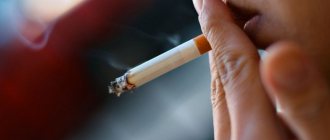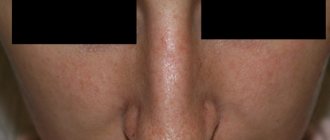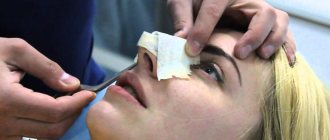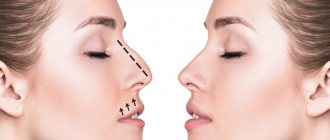Many of us, trying to get a beautiful and pleasant appearance, resort to various cosmetic surgeries. Rhinoplasty is considered the most common surgical procedure to correct the shape of the nose.
However, the human body tends to provide lost bone strength after surgery, so neoplasms often arise at this site. This causes the development of what is known as a “callus.” Such a neoplasm is quite rare, however, as a result of such a procedure, almost every patient undergoes it. Bone callus has nothing in common with ordinary callus; it does not represent hardened epithelium.
The growth is formed in the event of improper fusion of bones after surgery or nasal fractures, and therefore represents a normal regeneration process.
Why is “bone callus” dangerous?
Such an education does not mean anything serious for life, however, diagnosis and prevention must be carried out in a timely manner. In its absence, serious consequences may occur, including constant severe pain in the patient.
According to statistics, complications occur in 12 percent of victims. In 30 percent of cases, it is necessary to perform a second operation to prevent the proliferation of bone tissue.
When performing rhinoplasty, part of the bone and skin is removed. Operations of this type are always associated with changes in the structure of the nose. During interventions, the human body gives a protective reaction.
Unlike other body systems, bone tissue has a special healing process, which includes 3 successive stages:
- The first is accompanied by the appearance of neoplasms around the site of connective tissue damage;
- At the second stage, the development of bone tissue fibers is noted;
- Then the bone tissue thickens due to fiber calcification. Over time, it completely replaces the soft one.
When passing the third stage, a small growth forms right at the site of fusion. If grinding is done during rhinoplasty surgery, then rehabilitation almost always takes place with the appearance of such a callus. The size of the growth always depends on the individual characteristics of the human body, the depth of damage to the bone and surrounding tissues.
Among the main reasons for the development of such a callus are the following factors:
- The presence of individual characteristics of the body, which have a fairly high degree of tissue restoration;
- An equally important factor to ensure a successful operation is the experience of the surgeon. Professional specialists with extensive experience know several secrets that help to carry out the operation in such a way as to prevent bone tissue from growing in the future.
Prevention
Preventive measures against callus formation after rhinoplasty:
- Fulfilling doctor's orders during rehabilitation.
- Urgent contact with an observing specialist when the first signs of pathology appear.
- Careful selection of the clinic and surgeon for the operation. Since rhinoplasty is a common procedure and has an affordable price, it is important to analyze all the offers and choose the most proven one with a good reputation, without being tempted by low prices and dubious reviews.
Callus is the result of the body’s natural reaction to surgery, a kind of protective mechanism. Such formations after rhinoplasty often cause complications and pain in patients. Modern physiotherapy, medications and repeated surgery can solve the problem. How to effectively remove bone formation and save yourself from suffering?
Read in this article
What does callus consist of?
Callus has a special structure, which appears as a result of the restoration of bone tissue when it is damaged, and is a natural process. We can say that this neoplasm consists of connective tissue growing at the site of bone fusion.
Bone tissue also grows in three stages:
- The appearance of a provisional callus;
- Formation of osteoid tissue;
- Replacement of connective fibers with bone ones.
Almost always, cartilage tissue is formed first, which eventually turns into bone. This process takes about one year.
What is the best way to remove a callus after rhinoplasty?
Every person, in case of formation of a callus on the nose, tries to choose the safest methods for its removal.
With hypergrowth of such a formation, the following consequences are possible:
- Ugly hump on the nose;
- Swelling and edema;
- Deformation of the normal shape of the nose.
All of these phenomena not only noticeably worsen the appearance of the face, but also require repeated surgical interventions. Therefore, if the first suspicious symptoms appear, you should visit a plastic surgeon.
Repeated rhinoplasty is prescribed in extreme cases; more often, preventive measures are used to get rid of the problem. Secondary nose correction is also rarely performed; before it, a thorough study of the patient’s problem and special preparation for surgical intervention are required. This helps prevent problems with the appearance of the nose in the future.
If you follow the recommendations of specialists, it is quite possible to avoid the appearance of growths. In order to promptly detect callus hypertrophy, it is necessary to visit the surgeon every month. If violations are detected, the specialist will prescribe qualified treatment, with the help of which it will be possible to get rid of the problem in the shortest possible time.
According to numerous studies by experienced specialists, the development of callus occurs in young people under the age of 18 years. Therefore, a procedure such as rhinoplasty is recommended for people who have fully formed cartilage and bone tissue. Only a surgeon with extensive experience can determine the patient’s level of readiness for surgery.
What to do if the result is not what was expected?
If the patient is dissatisfied with the result, he should contact a plastic surgeon. After the consultation, it will become clear whether a repeat operation is needed, or whether other corrective procedures can be used. In any case, it is worth remembering that surgery is a risk.
The decision to undergo rhinoplasty is always made by the patient. When choosing a nose job, you should do your research carefully and then find a professional in plastic surgery.
What is considered a failed rhinoplasty and what to do in this case, we tell you in a separate article.
So, you noticed that you have a callus after rhinoplasty. How to remove it? You won’t be able to get rid of it yourself at home without the help of a qualified specialist, so it’s best to follow the following procedure:
- Send an appointment to the surgeon who performed your nose correction, regardless of how long during your rehabilitation the problem appeared. This is especially true for force majeure situations that require immediate medical attention.
- After passing the examination, the doctor will prescribe a treatment program for you, which must be followed strictly. This is the only way you can achieve the desired result and restore your appearance to its former attractiveness.
We suggest you read: How long does it take for joints to recover after gout?
It is worth noting that hyperplasia is most often diagnosed in young people under the age of 18, so they are strongly discouraged from going under the knife of a plastic surgeon. This is due to the fact that their bone skeleton has not yet been fully formed, but continues to develop, so in place of one eliminated defect, another can always appear. In addition, there is a high risk of developing various serious complications that can pose a great threat to human health.
Diagnosis of the disease
The development of callus can be diagnosed using radiography. In the picture it will be visible as a small shell at the site of tissue damage. Rehabilitation is a fairly long and complex process. Its main goal is to stop the growth of bone tissue.
Callus cannot be called a disease, because there is no treatment for it as such. However, there are many different techniques that can improve the patient’s nutrition, reduce the inflammatory process at the site of injury and prevent further growth of bone tissue.
In order to improve the healing of bone tissue, specialists prescribe the following therapy:
- Physiotherapy;
- Surgery to remove bone tissue;
- Treatment with medications.
Removal of callus is considered a radical method and is carried out only in cases where other therapy has not been effective.
Reasons for appearance
The formation of such growths occurs when bones heal after fractures. Frequent physical activity can also provoke pathology. The occurrence of these formations can be influenced by unsuccessful rhinoplasty (plastic surgery in the nose area).
Factors for the development of calluses are:
- improper fusion of bone tissue;
- early periods of loads on the fracture site;
- violation of the rules of rehabilitation actions;
- weakened immune system;
- endocrinological diseases;
- age;
- severity of fractures and their number.
- inflammation accompanied by a purulent process in the broken area;
- poor blood supply to the bone;
- improper treatment of a fracture.
This pathology can appear after bone fractures in the following parts of the human body:
The timing of the formation of bone calluses depends on the location of the fracture.
Experts distinguish several stages in the development of growths on bone tissue:
- Formation of a provisional growth (in the first week after injury).
- Transformation of the scar into cartilage tissue (this stage lasts about a month).
- The cartilage gradually ossifies (up to six months).
- Formation of a growth on the bone (one year after the fracture).
Calluses are a stage of bone fusion. But if this process occurs incorrectly, then such formation leads to undesirable consequences. In such cases, it is necessary to get rid of excess connective tissue.
How to get rid of heel spurs?
Readers constantly write letters to us with questions: “How to deal with foot fungus? What to do about unpleasant foot odor? and other pressing questions from our readers.” Our answer is simple, there are many folk remedies. But there is also a more effective remedy for fungus ARGO DERM, which doctors have now developed. Actually, A. Myasnikov gave an interview regarding this product, we advise you to read it.
Features of treatment
The goal of treatment is to eliminate the possible complication. For this, various techniques and methods are used. It is important to use them immediately after surgery. This approach makes it possible to get the desired result faster.
But if there are individual contraindications, effective procedures may be limited. At the first stage, the most important thing is to reduce inflammation at the site of injury using medications.
The tumor can also be removed through surgery. Surgical intervention is a last resort; it is used when other methods have not brought the desired result.
Often this defect after taking medications can manifest itself as the following unpleasant sensations:
- Increase in temperature;
- The appearance of severe pain and redness of the bridge of the nose;
- Difficulty breathing.
Recommendations from specialists are always aimed at effective and safe restoration of damaged tissue. Failure to comply with these rules can lead to serious complications for the patient. Regular visits to the surgeon will help you avoid such complications and undergo rehabilitation faster.
It is important to remember that the body's natural defense system can cause some problems as a result of rhinoplasty. But timely use of physical therapy and medications prevents the need for repeat surgery. As a result of a set of procedures and taking certain medications, the callus quickly resolves.
Taking good care of your body always allows you to maintain a beautiful appearance of your face and the functionality of your nose.
Physiotherapy
Patients who have developed a callus after nasal surgery, in addition to taking medications, are prescribed a course of physiotherapeutic procedures aimed at increasing the effectiveness of the main treatment and stimulating regeneration processes in the body. These include the following:
- Electrophoresis using enzyme and hormonal preparations.
- UHF therapy based on the effect of a magnetic field on the human body.
- Magnetic therapy - accelerates the healing process of tissues.
- Sonophoresis is ultrasound treatment using specialized equipment using 1% steroid ointment.
- Thermotherapy is treatment with heat.
As practice shows, the combination of these methods in combination with taking medications gives a positive result. But in very rare cases, no improvement occurs, so the patient requires surgery.
Taking medications
Drug therapy is considered a fairly common method of treating callus. It is most often used by surgeons as a treatment, as well as for prevention purposes.
In order to prevent the occurrence of hypertrophied callus, it is recommended to use drugs that contain glucocorticoid hormones that can eliminate swelling and ensure rapid bone recovery.
- The most common drug is Diprospan, which is administered by injection. It can increase scarring, relieve swelling and reduce inflammation;
- Another, no less well-known drug is “Kenalog”, the drug is administered intramuscularly, providing an excellent anti-inflammatory effect;
- Also highly popular is a homeopathic drug that has a complex effect on the skin - Traumeel S. The products are used externally or internally; the manufacturer makes them in the form of drops, ointments and tablets.
Diprospan Kenalog Traumeel S
What medications are prescribed
If a person has developed a callus after rhinoplasty on the bridge of the nose, then he is recommended to take anti-inflammatory drugs, as well as drugs that improve nutrition of the damaged areas of the bone skeleton. In most cases, these are drugs of the glucocorticoid group, which effectively relieve swelling and accelerate the tissue healing process.
The most famous medications in this group:
- “Kenalog” or “Diprospan”. They are produced in the form of injections, the drugs have a complex effect. Relieves swelling and accelerates the healing of soft and bone tissues.
- “Traumel S” is a homeopathic remedy that relieves inflammation.
In addition, to minimize the likelihood of infections entering the body, doctors prescribe antibiotics to patients.
Physiotherapeutic procedures
Many people prefer to use various procedures that can help restore the nose to its previous shape. Even experienced specialists recognize them as highly effective. With physiotherapy, it is possible to ensure gradual resorption of the callus and also activate its regeneration.
The most common methods of such treatment are the following:
- Using electrophoresis simultaneously with lidase and hydrocortisone preparations. This method can bring a good effect not only at the early stage of callus development, but also with significant compaction;
- Thermotherapy or thermotherapy is also considered effective;
- A good result can be obtained with the help of ultrasound, which is carried out using steroid ointment or phonophoresis;
- It is also possible to use UHF or magnetic therapy.
Everyone understands that it is best to prevent the development of a callus on the nose. It is much easier to carry out thorough prevention with all precautions; in this case, you can avoid such unpleasant consequences, which will then be much more difficult to get rid of.
As preventive measures, experts advise following several rules:
- Contact a surgeon as soon as possible if initial signs or some symptoms of growth development appear;
- Strictly follow all doctor’s recommendations during treatment;
- Choose the right clinic and specialist who will perform rhinoplasty. Such surgical intervention is quite common nowadays, it has a very optimal cost, so you should carefully navigate among the numerous offers in order to choose the most optimal option for yourself.
Cost of repositioning nasal bones for fractures
The prices indicated in the price list may differ from the actual prices. Please check the current cost by calling +7 495 104 8605 (24 hours a day) or at the GMS Hospital clinic at the address: Moscow, st. Kalanchevskaya, 45.
| Name | Common price | Price with 30% discount |
| Closed reduction of the nasal bones | 58,000 rub. | 40,600 rub. |
| Reposition of a closed fracture of the nasal bones with PSO wound | RUB 52,715 | RUB 36,901 |
| Reposition of an open fracture of the nasal bones with PSO wound | 100,000 rub. | 70,000 rub. |
| Reposition of bone fragments in a closed fracture | RUB 25,835 | RUB 18,085 |
Prices for the most popular services are indicated with a 30% discount, which is valid when paying in cash or by credit card. You can be served under a VHI policy, pay separately for each visit, sign an agreement for an annual medical program, or make a deposit and receive services at a discount. On weekends and holidays, the clinic reserves the right to charge additional payments according to the current price list. Services are provided on the basis of a concluded contract.
Plastic cards MasterCard, VISA, Maestro, MIR are accepted for payment. Contactless payment with Apple Pay, Google Pay and Android Pay cards is also available.
Make an appointment We will be happy to answer any questions Coordinator Oksana
Recommendations from experienced specialists
To prevent the occurrence of callus, experienced professionals give several tips; by adhering to these rules, you can maintain your appearance as before.
- In the first few days after the procedure, it is recommended to remain in bed; try to comply with this requirement, because this will allow you to get a good result not only regarding your appearance, but also your well-being;
- In the first 2-3 weeks, it is best to stay at home, and you should also try to avoid strenuous physical activity;
- It is not recommended to blow your nose at first; to clean it, it would be much better to use regular cotton swabs;
- Complex strength exercises are not performed; heavy lifting can be carried out no earlier than after 2 months;
- If you wear glasses, you should discard them during rehabilitation. If necessary, they can be worn for a short time;
- Try not to eat foods that are too cold; it is much better to warm everything up;
- For a month you should forget about beaches, saunas, steam baths, and solariums. This will help avoid severe overheating in the sun and under strong steam.
By following all of the above recommendations, a patient who has undergone rhinoplasty will be able to recover quickly and also prevent the occurrence of “callus.”
Repeated surgery
If a person not only has a callus after rhinoplasty, but also exhibits some other symptoms, then doctors have no choice but to resort to another correction of the olfactory organ. Causes for concern are:
- increased body temperature;
- excess fluid accumulation;
- redness of the skin of the bridge of the nose.
It is important to understand that surgery cannot completely eliminate the likelihood of repeated relapses. It will be possible to draw final conclusions about the success of treatment after 6-12 months.











